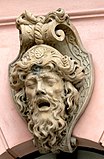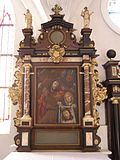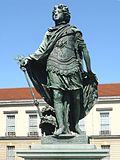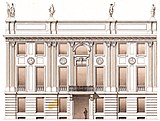Andreas Schlueter (architect)
Andreas Schlueter (born March 5, 1634 in Danzig ; † before June 23, 1714 in Saint Petersburg ) was an important German sculptor and architect in Danzig, Warsaw , Berlin and St. Petersburg . His most important works include the reconstruction of the palace and the Amber Room in Berlin, as well as the designs for the Peterhof Palace near St. Petersburg. He is known as the " Michelangelo of the North".
life and work
Danzig
The father Andreas Schlueter (the elder) was a blacksmith from Brandenburg an der Havel , who married Barbara Stange in Danzig in 1630. Andreas Schlueter (the younger) attended the academic high school in 1647 and from 1651 did an apprenticeship as a sculptor and stonemason with Richter. In 1656, after graduating, he was accepted into the masons, stonemasons and sculptors guild in Danzig. From 1660 to 1662 he wandered in Hamburg.
Schlueter lived in Gdansk again by 1675 at the latest. He carried out sculptures in the new Royal Chapel , carved the high altar of the monastery church in Oliva and created epitaphs in Pelplin .

Warsaw
From 1690 Andreas Schlueter worked at the Wilanów Palace in Warsaw on behalf of King John III. Sobieski , presumably under Augustyn Wincenty Locci .
Even in these early works by Schlüter, there is a wealth of variation and pronounced individualization of facial types.
In the last years of his stay in Poland, the work in Żołkiew near Lemberg , the ancestral seat of the royal family, can probably be recognized, where in 1694 several tombs for members of the Polish king were erected in the local church. Not all of the tombs have survived, but those of Stanisław Daniłłowicz and Jakub Sobieski that still exist - mainly due to their stylistic similarities to stucco figures in Wilanów Castle - can certainly be attributed to Schlüter.
Berlin and Friedrich III.

In 1694, Elector Friedrich III. , Schlueter to Berlin as court sculptor. The elector first sent him to France, the Netherlands and Italy; there he was supposed to procure plaster casts of ancient sculptures for the academy in Berlin, where he also had a teaching position. During these trips at the latest, Schlüter came into contact with works by Michelangelo Buonarroti and Gian Lorenzo Bernini , which were to have a lasting impact on him.
Schlüter's first works in Berlin are probably ancient river and sea deities that were once located on the Long Bridge .
The first really big project for Schlüter then presented the 1695 according to plans Arnold Nerings begun armory whose window arches it with sculpted keystones (adorned the facade ceremonial helmets, courtyard draft shields with the heads die warrior who executed by Georg Gottfried Weyhe Meyer were). Several stonemasons and other craftsmen worked there under his direction, including David Christoph Sapovius from Gdansk.
At the same time, Schlüter also made the models for a statue of Frederick III, which was originally to be set up in the courtyard of the armory, and for an equestrian statue of the Great Elector that was set up on the Long Bridge. Both bronze sculptures have been at Charlottenburg Palace since the post-war period : the statue of Frederick III / I. as a copy since 1969 in front of the New Wing, the original equestrian statue of the Great Elector on a copied marble plinth in the courtyard since 1954. After Nering and Martin Grünberg , Schlüter took the position of construction manager at the armory in 1699 and was appointed palace construction director in the same year. In this position he redesigned the facade of the Berlin Palace towards the city and created the interior of the Schlüterhof , which was later named after him, with elements of the Italian Baroque and the burgeoning classicism . He also designed the interiors of the Hohenzollern Palace, including the spiral staircase and the knight's hall.
Schlüter also made designs for the casting house and the small stables as well as for the parochial church and a tower (the latter two were discarded, however). From 1702 to 1704 the Alte Post (also called Wartenberg-Palais) was built on the corner of Burgstrasse and Königstrasse in Berlin according to plans by Schlueter , and the Schlueter decorated with relief medallions with allegories of postal virtues such as punctuality and circumspection.
He originally designed the well-known Amber Room for Lietzenburg Castle . It was made from 1701 and then, contrary to the original plan, used for a room in the Berlin City Palace. In 1716 it was finally given to the Russian Tsar Peter the Great . Schlüter also made a portrait bust of Landgrave Friedrich II of Homburg-Hessen , which was also cast by Jacobi between 1701 and 1704. In 1700, the tomb for the court goldsmith Daniel Male and his wife with the motif of death seizing a boy was built in the Nikolaikirche in Berlin . Shortly before, Schlüter had to mourn the death of his youngest son Gotthardt. Furthermore, Schlüter created the pulpit in Berlin's Marienkirche in 1703. Here the influence of Bernini is very clearly noticeable through the similarities with his Cathedra Petri . Queen Sophie Charlotte died in 1705 , which is why Schlüter was commissioned to design a splendid sarcophagus, which was also cast by Jacobi. In addition to all of his activities, Schlüter held the office of director of the Berlin Academy of the Arts from 1702 to 1704 .
Mint tower disaster and dismissal
At the height of his career, Schlüter was given the momentous order to replace the electoral mint with a building appropriate to the country's new royal dignity. Schlüter made several bold designs for a tower, which was originally supposed to rise up to a height of 96 meters, contain a memory for the water arts of the palace garden and at the top a carillon. A first draft dates from the winter of 1701/1702 and construction began in 1702. Static problems quickly arose, which were primarily caused by the swampy, apparently insufficiently secured ground. The foundations of the tower began to slide and deep cracks appeared in the walls.
Despite massive reinforcements of the foundation and the walls, the tower, which was raised to a height of 60 meters after four years, began to totter. In the process, scaffolding even collapsed, which the builders buried under. Another misfortune was added: Schlüter had built a pleasure palace for the king in the spa town of Freienwalde . It was located directly on a sand hill, which promptly slipped due to a storm during the king's stay there, which is why the king never returned to the place and Schlueter fell even more out of favor. In addition, Schlüter had many envious people - especially Johann Friedrich von Eosander - who took the opportunity to point out construction defects that had already occurred in the armory and the Berlin Palace and thereby further damage Schlüter's reputation.
After several years, which Schlüter had spent more or less inactive, withdrawn and allegedly attempting to construct a perpetual motion machine , apart from a few sculptural commissions , he was assigned a final building project in Berlin: a country house ( Villa Kamecke ) for privy councilor Ernst Bogislav von Kameke in his private pleasure garden in Dorotheenstadt , which Schlueter built from 1711 to 1712. On December 6, 1897 , August Leo Zaar (1860–1911) attributed the no longer preserved "health and healing wells" to Andreas Schlueter with his reconstruction drawing showing the front view as well as the floor plan. After the death of Frederick I in 1713, Schlüter was finally dismissed from court service.
Russia
In the summer of 1713 he traveled to Russia (where he possibly entered the service of Tsar Peter the Great , who had just started to have Petersburg expanded). Nothing has come down to us about this last brief period in Schlüter's life, apart from the news of his death, which reached Berlin on June 23, 1714.
marriage and family
Andreas Schlueter was married to Anna Elisabeth Spangenburg. They had several children.
Works (selection)
Andreas Schlueter first worked as a wood carver and stone mason. From around 1695 he also designed buildings and led the construction management, which were carried out by a group of stonemasons and other craftsmen.
| year | place | building | image | Remarks |
|---|---|---|---|---|
| 1674-76 | Pelplin near Danzig | Monastery church | Epitaph for Sambor II and Mestwin II, with painter Andreas Stech , probably also an altar, mentioned in two documents | |
| around 1675/90 | Danzig | Town houses Langer Markt 3 and 7/8, Jopengasse | Stone carving on the facade or interior, attributions (probably not in Langer Markt 20 and Hundegasse 25) | |
| 1680/81 | Danzig | Royal Chapel |

|
Building sculptures / exterior sculptures (attribution) |
| around 1682 | Frauenburg (Frombork) | Dom | Epitaph for Joachim Pastorius, attribution (probably not another epitaph) | |
| around 1683/89 | Oliva near Gdansk | Monastery church | Main altar, four side altars with painter Andreas Stech , and the portal of the entrance (attribution) have been preserved | |
| 1690/94 | Warsaw | Wilanów Palace | extensive stone carvings | |
| around 1691/94 | Warsaw | Krasiński Palace |

|
Gable reliefs attribution |
| 1693/94 | Żółkiew , now Shovkva | church | several tombs for members of the royal family | |
| 1695 | Berlin | Long bridge | River and sea deities (not preserved) | |
| 1695/1700 | Berlin | Armory |

|
Construction management since 1698, drafts for dying warriors (carried out by Georg Gottfried Weyhenmeyer ), received |
| around 1695 | Berlin | Statue of King Frederick I | ||
| around 1695 | Berlin | Equestrian statue of the Great Elector | ||
| 1695-1702 | Berlin | lock | Construction management of the renovations, with the facade and interior design, Schlüterhof, completed by Eosander (partially reconstructed) | |
| around 1700 | Berlin | Royal foundry | draft | |
| around 1700 | Berlin | Small stables | draft | |
| around 1700 | Berlin | Parochial Church | draft | |
| 1701 | Berlin | City Palace, Amber Room | 1716 to Tsar Peter I, lost in 1944/45, now a replica in Tsarskoe Selo | |
| 1702/1704 | Berlin | Wartenberg Palace | Draft, not received | |
| 1703 | Berlin | Marienkirche | pulpit | |
| 1711/12 (or 1713/14?) | St. Petersburg | Peters I. Summer Palace | external bas-reliefs, attribution | |
| 1713/14 (?) | Peterhof near St. Petersburg | Monplaisir Palace | Draft, attribution | |
| 1713/14 | Peterhof | lock | Draft, attribution, completed by Braunstein by 1723 | |
| 1713/14 | Peterhof | Kikin Palace | Draft, attribution, completed in 1720 |
Honors
Andreas Schlueter was already venerated by his contemporaries as the " Michelangelo of the North".
During the construction of the Düsseldorf Art Academy (1875–1879) his name was carved along with other important sculptors in the frieze of the facade on the west side (Rhine side).
On one of the pillars in the hall of the Hamburg City Hall is a medallion with the relief of Andreas Schlueter.
For the former Berliner Siegesallee , the sculptor Gustav Eberlein designed a marble bust of Schlüter as a side figure of monument group 26 to the central statue for the first Prussian King Friedrich I , unveiled on May 3, 1900. The bust shows Schlüter in a simple sculptor's smock, like him examining the mask of a dying warrior in pain. The bust has been preserved with slight damage and has been kept in the Spandau Citadel since May 2009 .
Exhibitions
- 2014: SCHLOSS BAU MEISTER. Andreas Schlueter and baroque Berlin . Bode Museum , Berlin.
Movies
- Schlüter's life with Heinrich George in the lead role was filmed in 1942 under the title “Andreas Schlüter” (directed by Herbert Maisch ). Aspects of his biography were, however, handled very freely.
literature
Overall representations
- Mariusz Karpowicz : Andrzej Schlüter - rzeźbiarz krolów [Andreas Schlüter - sculptor of kings]. Warszawa, Muzeum Króla Jana III w Wilanowie, Warszawa 2014. 238 pp.
- Goerd Peschken : Andreas Schlüter architectus. Catalog raisonné in drawings. Ludwig, Kiel 2014 excerpt
- Heinz Ladendorf : Andreas Schlüter (= The People's Art Books. Large Series, Vol. 19). Rembrandt-Verlag, Berlin 1937 (new edition, with an afterword by Helmut Börsch-Supan , as: Andreas Schlueter. Builder and sculptor of the Prussian Baroque. Seemann, Leipzig 1997, ISBN 3-363-00676-4 ).
- Cornelius Gurlitt : Andreas Schlueter. Wasmuth, Leipzig 1891.
- Karl Friedrich von Klöden : Andreas Schlueter. A contribution to the art and building history of Berlin (= biographies of famous master builders and sculptors. Vol. 1, ZDB -ID 2627540-5 ). Riegel, Berlin / Potsdam 1855.
Lexicon article
- Bernd Nicolai : Andreas Schlueter. In: New German Biography (NDB). Volume 23, Duncker & Humblot, Berlin 2007, ISBN 978-3-428-11204-3 , pp. 111-113 ( digitized version ).
- Paul Ortwin Rave : Andreas Schlueter. In: Hermann Heimpel , Theodor Heuss , Benno Reifenberg (Eds.): The Great Germans. German biography. Volume 1: From Charlemagne to Andreas Schlueter. Propylaeen, Berlin 1956, pp. 600-666.
- Robert Bruck : Schlueter, Andreas . In: Allgemeine Deutsche Biographie (ADB). Volume 55, Duncker & Humblot, Leipzig 1910, pp. 184-194.
- Hamburgisches Künstler-Lexikon , Die Bildenden Künstler Vol. 1, edit. by a committee of the Association for Hamburg History , Hoffmann and Campe , Hamburg, 1854, p. 220 ff., ( online Hamburg State and University Library).
Individual aspects
- Hans-Ulrich Kessler: Andreas Schlueter. Creator of Baroque Berlin. Catalog book for the exhibition Berlin, Bode-Museum, April 4 to July 13, 2014. Hirmer, Munich 2014, ISBN 978-3-7774-2199-5 .
- Karl Schade: The Schlüter pulpit in the Berlin Marienkirche (= DKV art guide. No. 641). Deutscher Kunstverlag, Munich / Berlin 2008, ISBN 978-3-422-02044-3 .
- Guido Hinterkeuser: The Berlin Palace. The renovation by Andreas Schlueter. Siedler, Berlin 2003, ISBN 3-88680-792-4 .
- Isolde Dautel: Andreas Schlueter and the Zeughaus in Berlin. Michael Imhof Verlag, Petersberg 2001, ISBN 3-932526-87-2 (also: Tübingen, University, dissertation, 1999).
- Erich Hubala : The Berlin Palace and Andreas Schlueter. In: Margarete Kühn , Louis Grodecki (ed.): Commemorative publication Ernst Gall . Deutscher Kunstverlag, Munich / Berlin 1965, pp. 311–344.
- Eva Mühlbächer, Edith Fründt (Hrsg.): Andreas Schlüter and the sculpture of his time. A commemorative exhibition on the occasion of the 250th anniversary of his death. State Museums in Berlin, Berlin 1964.
- Heinz Ladendorf : The sculptor and builder Andreas Schlueter. Contributions to his biography and the Berlin art history of his time (= research on German art history. Vol. 2, annual edition of the German Association for Art History . ). German Association for Art History, Berlin 1935. ( Text )
Web links
- Literature by and about Andreas Schlueter in the catalog of the German National Library
- Works by and about Andreas Schlüter in the German Digital Library
- Search for Andreas Schlüter in the SPK digital portal of the Prussian Cultural Heritage Foundation
- Andreas Schlueter - German biography
- Sculptural decorations of the armory - German Historical Museum
- Exhibition SCHLOSS BAU MEISTER. Andreas Schlueter and Baroque Berlin - National Museums in Berlin
Individual evidence
- ↑ Maria Babnis : Wystroj kościóła klasztornego (About the renovation work on the Oliva monastery church) Wilanów Palace ( Memento ), citing excerpts from city books in the city archive with further dates 1675 in Dzg, 90 in Warsaw, 94 in Bl, 1707 in St. Petersburg and date of death 5th 1814 ; see. also this. Andreas Schlueter Encyklopedia Gdańska
- ↑ Maria Babnis: Wystroj kościóła klasztornego (About the renovation work on the Oliva monastery church) Wilanów-Palac, with detailed biographical information in the last paragraphs ( Memento )
- ↑ Older German research assumed an Andreas Schlueter, who was born in 1659 as the son of Wilhelm and Regina Schlueter, this identification is incompatible with the known data, a birth in Hamburg in 1662 or 1664 was also considered
- ^ Erich Keyser: Andreas Schlueter and Danzig. In: Communications of the West Prussian History Association. 30. 1931. pp. 39–42, especially p. 39 , for Andreas Schlüter (II.)
- ^ Kevin E. Kandt: Schlueteriana III: Studies in the Art, Life and Milieu of Andreas Schlueter . Lukas Verlag, Berlin 2015. P. 70 with erroneous assignment to Andreas Schlueter the Elder
- ↑ Andreas Schlüter Gedanopedia after Encyklopedia Gdańska , Gdańsk 2012, with information on the Danziger time
- ^ R. Borrmann: The old post office in Berlin . In: Zeitschrift für Bauwesen , Volume 40 (1890), Col. 421–432, Plate 68–69. Digital copy (link does not work) in the holdings of the Central and State Library Berlin .
- ↑ on Schlueter's draft I see: Friedrich Adler : From Andreas Schlueter's life. (1.). In: Centralblatt der Bauverwaltung . Vol. 3, No. 1, January 6, 1883, pp. 2-4, accessed on January 28, 2014.
- ↑ to the IIt. Design and start of construction in 1702 and demolition in 1707 see: Friedrich Adler: From Andreas Schlueter's Life. (Continuation). In: Centralblatt der Bauverwaltung. Vol. 3, No. 2, January 13, 1883, pp. 13-16, accessed on January 28, 2014.
- ↑ on the laying of the foundation stone on October 19, 1708, after the complete removal of the mint tower see: Friedrich Adler: From Andreas Schlüter's life. (Enough). In: Centralblatt der Bauverwaltung. Vol. 3, No. 3, January 20, 1883, pp. 22-24, accessed on January 28, 2014.
- ^ Villa Kamecke
- ^ Reconstruction drawing , accessed on February 9, 2013
- ↑ Kevin E: Kandt: A recently discovered archival source for the "Epitaph of Sambor II and Mestwin II" at Pelplin cathedral and some unknown biographical notes on Andreas Schlueter the Elder. In: Barok . 8/2. 2001. pp. 47-57. Digitized with German and Latin extracts from documents; Kandt erroneously ascribes the epitaph to another older Andreas Schlueter, but only one sculptor with this name is known in the Danzig documents, cf. Maria Babnis, Vystroy
- ^ Andreas Schlueter the younger Wilanów Palace, first illustration
- ↑ Maria Babnis : Wystroj kościóła klasztornego (About the renovation work on the Oliva monastery church) Wilanów-Palac, with a photo of the main altar (Polish)
- ↑ Zygmunt Iwicki: The high altar of the cathedral in Oliva. A work by Andreas Schlueter . University publishing house, Freiburg im Breisgau 1980. (Dissertation)
- ^ Sculpture jewelry Zeughaus Berlin
- ^ Sculptural jewelry German Historical Museum
- ↑ Uta Lehnert: The Kaiser and the Siegesallee. Réclame Royale. Dietrich Reimer, Berlin 1998, ISBN 3-496-01189-0 , p. 196.
| personal data | |
|---|---|
| SURNAME | Schlueter, Andreas |
| BRIEF DESCRIPTION | important German architect and sculptor |
| DATE OF BIRTH | March 5, 1634 |
| PLACE OF BIRTH | Danzig |
| DATE OF DEATH | before June 23, 1714 |
| Place of death | St. Petersburg |





